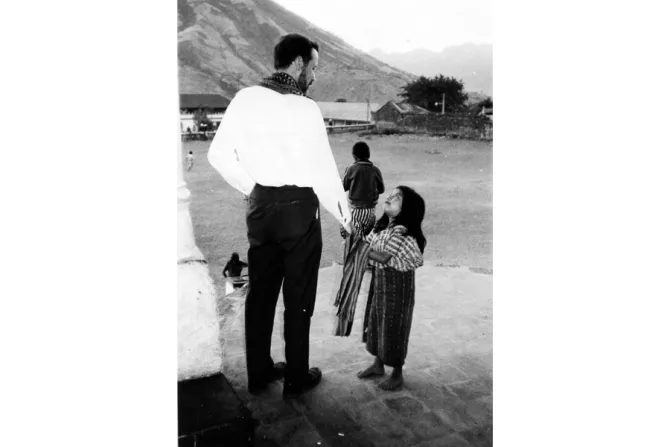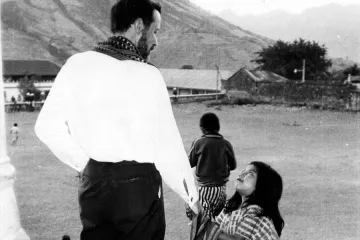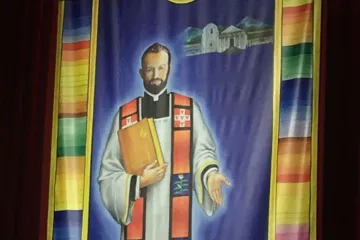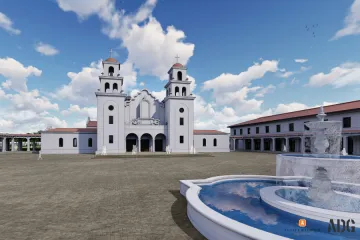The group from Oklahoma City, along with a number of other pilgrims from the US, went to Guatemala last week to visit some of the places where Rother served in the 1960s and '70s, including his mission parish in Santiago Atitlan.
Archbishop Coakley celebrated Mass Sunday morning at St. James the Apostle Catholic Church in Santiago Atitlan.
"We had two beautiful Masses, and the people there are very traditional in preserving their Mayan culture, Mayan dress, and they came in great crowds to the Masses that we celebrated in both Santiago Atitlan and in Cerro de Oro," he said.
Fruits of Blessed Rother's ministry
A group from the archdiocese generally visits Guatemala every five years, and this was the first year the group has visited since Rother's beatification in 2017. Last year Coakley had stayed home, because he wanted to be in the archdiocese for Rother's first feast day.
"[On Monday] I met a priest who had been baptized by Father Stanley many years ago, and I think he was the first Tz'utujil priest to be ordained from the diocese," Coakley said.
"That was a quite evident fruit of Blessed Stanley's ministry. Many things are still flourishing there that he was a part of, that he helped to start. The parish is strong, many vocations have come from the parish, he developed a farming cooperative, some agricultural projects that are still going strongly."
"One of the things that really helped him connect with the people is that he took the time and made the effort to learn their language, which was a very difficult Mayan dialect," Coakley continued.
He also helped to translate the Bible into their language, organizing a team to translate the New Testament so they could read it at Mass. That translation is still used to this day.
"He acquired the skill and proficiency so that he could preach in it, could speak to the people in that, and that was really some of the key to his success. That and the fact that he just loved being with them. He would work with them, he would eat with them in their homes, visit them, so it was a powerful witness that endeared him to the people and he had certainly fallen in love with the people themselves."
Blessed Rother's influence is still felt in the parish and in the town, especially since relics of the priest are kept in the church for the people to venerate.
(Story continues below)
Subscribe to our daily newsletter
"The love that the people of Santiago Atitlan have for Blessed Stanley is very apparent," Father Josh Mayer, a priest of the Diocese of Gallup who was also visiting Guatemala for the feast day, told CNA.
"At the parish, his presence is everywhere – his heart and his blood are in the Church, the room that he was killed in has been converted into a chapel in his honor, the parochial school has been named after him. Blessed Rother is well-known all over town."
Mayer is pastor of two parishes in the Diocese of Gallup – St. Mary in Bloomfield and St. Rose of Lima in Blanco – which have a partnership with a Guatemalan school called Escuela Integrada. Father Mayer said the vibrancy of the parish where Rother served is an inspiration to him, especially the Chapel of Perpetual Adoration, which he says is always full when he visits.
"The Catholic community in Santiago Atitlan is incredibly vibrant and active. I've never seen as many altar servers as they have at each Sunday Mass in Santiago – it's incredible," he said.
"The Eucharistic Ministers and lectors and catechists and other ministry groups are all incredibly well organized and everyone takes their roles very seriously. The people are very proud of what they do for Jesus and His Church. Every time I visit the parish of Santiago Apostol, I'm inspired with a vision of what we could do at our parishes back home."
Despite the vibrancy of the parish, Mayer reflected that Guatemala is a "land of extremes": a beautiful, rich environment populated by people notable for their kindness, warmth, and sense of community and family life. At the same time, material poverty, malnutrition, envy, extortion, and abuse are common.







